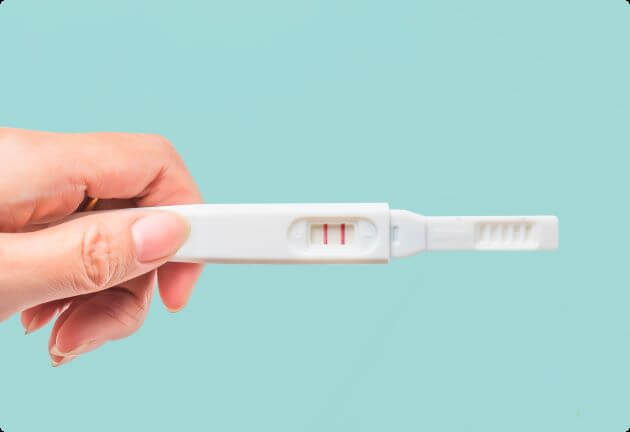Vaginal discharge is mucus and/or fluid that comes out of the vagina. Vaginal discharge is necessary to keep the vagina moist and clean. Vaginal discharge changes under the influence of hormonal changes, such as during different times of the menstrual cycle, during menopause and during pregnancy. Brown vaginal discharge can also occur under normal, healthy conditions, but can also indicate an underlying pathology.
In this blog, we will teach you all about the different causes of brown vaginal discharge. After this blog, you’ll know exactly when brown discharge can be considered normal, but you’ll also know when it’s best to visit your doctor for further investigation. Read on quickly.
What is brown discharge?
Vaginal discharge refers to the fluid that comes out of the vagina or cervix. It is a normal bodily phenomenon and its purpose is to keep the vagina clean and moist. The amount, colour and consistency can vary depending on the menstrual cycle and/or hormonal changes, but can also refer to any underlying disease conditions.


When vaginal discharge is brown in colour, it often indicates blood mixed with vaginal discharge. One of the most common reasons for brown discharge is old blood leaving the body. At the beginning or end of the menstrual cycle, blood may stay in the uterus longer and darken before being shed. This can result in a brownish colour of the discharge instead of bright red menstrual blood.
Besides menstruation, brown discharge can also occur due to hormonal changes, such as when starting or stopping contraception, during ovulation or during pregnancy.
Although brown vaginal discharge is often harmless, it is advisable to remain vigilant. If brown vaginal discharge persists for a long time or causes additional symptoms, it is advisable to have additional tests. Sometimes brownish vaginal discharge can indicate infections, such as a vaginal infection or a sexually transmitted disease (STI).
Significance of brown discharge at different times
Brown vaginal discharge can have several causes. To differentiate between different causes of vaginal, brown discharge, we have made an easy-to-read list of the significance of brown discharge during different times:
Brown discharge before menstruation:
Brown discharge indicates old blood mixed with vaginal discharge. When blood stays in your body for a longer period, it can turn brown in colour. When you have brown, vaginal discharge just before your period, it can indicate old menstrual blood from your previous period.



People using the pill as a contraceptive method may also have regular brown discharge. This is due to the influence of the hormones being taken and is harmless. This is more common during the first months of using the contraceptive pill or when you swallow the pill for a longer period of time. You call this breakthrough bleeding.
Brown discharge after menstruation:
Also just after menstruation, some old (menstrual) blood may still mix with vaginal discharge, giving it a brown colour. This is a harmless symptom and usually lasts for a few days until after menstruation.

If you regularly have brown discharge between periods, i.e. not just after or just before your period, it is advisable to make an appointment with your GP. Your GP can then advise whether additional testing is advisable, such as an STI test or a smear test. Always get advice from your own doctor for this.
Brown discharge during menopause:
During menopause, it is normal for your periods to become increasingly irregular and at some point stop. This irregular menstrual cycle may be accompanied by brownish discharge. Again, this is old blood that has been staying in the body for a long time. This is explained by the hormonal changes during menopause.


If you have bleeding or brownish discharge more than one year after your last period, it is important to make an appointment with your GP. Postmenopausal bleeding can have several causes and in many cases is harmless, for example due to declining oestrogen levels, vaginal dryness or a polyp. However, as postmenopausal blood loss can also be a sign of uterine (neck) cancer, it is always important to make an appointment with your GP when you have postmenopausal blood loss.
Brown discharge during pregnancy:
Brown discharge can occur throughout pregnancy and is usually harmless. If the discharge suddenly increases a lot or if there is a lot of bright red bleeding, contact your doctor or midwife immediately.

Brown discharge after sexual contact:
Brown discharge after sexual contact may indicate contact bleeding. This can have a number of causes. If you had sexual contact around your period, it may involve old blood coming out. Brownish discharge can also occur when the vagina was too dry during sexual contact. Small wounds can then form that later cause brownish discharge.
If, however, contact bleeding occurs continuously or is accompanied by abdominal pain and/or back pain, it may be a soa, such as chlamydia or gonorrhoea. It can also be a sign of cervical cancer in rare cases. So, do you have blood loss or brownish discharge for an extended period of time after sexual contact? If so, make an appointment with your GP for additional tests.
Related tests



The normal course of brown discharge
The course of brown vaginal discharge depends on the cause of the discharge. So different causes of brown discharge have a different course:
- Surrounding your period: When brown discharge occurs around your period, the discharge usually stops 2-3 days after your period. If you often experience brown discharge between periods, it is advisable to make an appointment with your GP.
- During contraceptive pill use: When brown discharge occurs during contraceptive pill use, it usually stops when you use the contraceptive pill for several months. Brown discharge may also return when you continue taking the pill for a longer period of time.



- During the menopause: If you suffer from brown discharge during the menopause, it may occur throughout the menopause. When brown discharge occurs more than a year after the last menstruation, make an appointment with your GP.
- During pregnancy: Brown discharge during pregnancy may persist throughout pregnancy. Make an appointment with your doctor or midwife if this discharge suddenly becomes much more or changes to bright red bleeding.
What to do in case of brown discharge?

Most of the time, brown discharge is harmless. However, sometimes it is advisable to make an appointment with your (GP) for further investigation. This is the case when you suffer from brown discharge for a long time, when you regularly have brown discharge after sexual contact, when you have brown discharge more than a year after your last period or when the brown discharge is accompanied by other symptoms, such as abdominal pain, back pain or pain when urinating. This is to rule out multiple causes. In addition, would you like to have further investigations carried out? At Easly, we offer the female health test, which tests for multiple conditions that can cause altered discharge.
Sources:
- Women’s Healthcare Centre – Blood loss after menopause
- NHG guidelines – Vaginal Blood Loss
- NHG guidelines – The menopause
- Home doctor – I have vaginal blood loss more than 1 year after my last period
- Home doctor – I lose blood from my vagina after sex
- Home doctor – I sometimes lose blood when I am not menstruating









